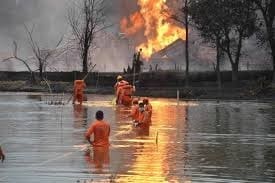The Oil India Ltd has said the fire in the Assam oil field may take four weeks to be brought under control. There is fear that gas leak and oil spill may have caused cureless damage to local ecology.
On June 5, the World Environment Day, a group of environment activists, local residents and students staged protest demanding compensation for the damage caused by the blowout in the well(s) managed by the Oil India Ltd (OIL). This did not make national headline.
A blowout from an oil field is an uncontrolled release of gas. The blowout had begun at the
Baghjan village in Tinsukia district of Assam on May 27. A statement by the OIL confirmed this.
The protest took place on the 10th day of the continued blowout. It became a national headline on June 9, when the uncontrolled release of gas from the oil well caught massive fire – almost a fortnight after the blowout began.
The protesters said five people had died due to gas leakage. The district administration refused to confirm that the deaths occurred due to gas leakage. A magisterial inquiry was ordered to ascertain the cause of deaths.
The next day, that is June 6, the OIL announced compensation as reported by local media that Rs 30,000 would be provided to each of the affected families as immediate relief.
This protest has given impetus to a campaign that appeared weakening in Assam.
Environmentalists have been protesting in Assam for weeks against a decision to allow drilling and testing of hydrocarbons at over half-a-dozen locations under the Dibru Saikhowa National Park (DSNP).
The DSNP, combined with the wetland Maguri-Motapung Beel having a rich heritage of bird
species, is in the vicinity of the oil field where blowout happened. Resultant fire has caused damage in both DSNP and Maguri-Motapung Beel.The Centre gave environmental clearance to drilling in the region in May. But environmentalists have been campaigning against such a move for many months.
Following the blowout, the locals activists have written to Assam Chief Minister Sarbananda
Sonowal demanding that the incident be properly investigated and responsibility fixed, and that the OIL should stop oil exploration and drilling activities in the biodiversity zones. Meanwhile, the OIL has formed an inquiry committee to find out if blowout occurred due to human error. Teams from the ONGC, OIL and Singapore-based Alert Disaster Control joined hands to control the fire and mitigate damage to the well and environment.
The OIL has now said that based on assessment by the Singaporean firm Alert, the Assam oil field fire could be controlled in four weeks. The OIL also lost two of its firefighters involved in controlling the situation at the site.
Blowout and fire might have caused irreparable damage to the local environment which has been the major source of livelihood for local population.Blowouts leave behind huge volumes of residue as gas condensate. Reports suggest that gas condensate was seen as far as 5 km from the site of blowout. Gas condensate is a mixture of chemical compounds that are toxic for land, vegetation and known carcinogens. It can turn soil infertile, kill vegetation and leave people battling with cancer. There tea gardens in the nearby areas. Oil has spilled over to Dibru river — which is believed to have given the name to Dibrugarh district of Assam. Reports say a film of oil has been seen in the river that passes through the Maguri wetlands and runs along the DSNP.
The wetland is host to some of the most vulnerable species of birds such as Swamp Francolin, Marsh Babbler, Greater Adjutant and Pallas’s Fish-eagle, Red-headed Vulture and White-bellied Heron. BirdLife International recognised this wetland as Important Bird and Biodiversity Area in 1996.
Environmental activists say the wetland has been destroyed by the blowout.River Dibru is a tributary of River Lohit, which becomes Brahmaputra in the lower reaches. Brahmaputra river system is home to Gangetic dolphins. Recently, image of a carcass of a Gangetic dolphin was widely shared on social media with people claiming that the endangered mammal died due to oil spilling during the blowout.

